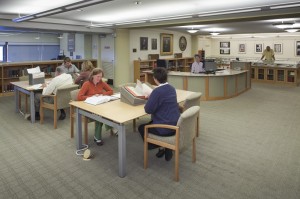 The Watkinson is proud to announce its admission to the New England Regional Fellowship Consortium (NERFC), which now boasts eighteen members from Connecticut to Maine. Scholars locally, nationally, and abroad can now apply for a fellowship to visit the Watkinson (and others, like our Hartford sister CHS) during the next funding cycle, which will be the 2013-14 academic year. In the meantime, we are full voting members, and will be taking the opportunity to discuss our collections with the membership and learn about theirs in turn.
The Watkinson is proud to announce its admission to the New England Regional Fellowship Consortium (NERFC), which now boasts eighteen members from Connecticut to Maine. Scholars locally, nationally, and abroad can now apply for a fellowship to visit the Watkinson (and others, like our Hartford sister CHS) during the next funding cycle, which will be the 2013-14 academic year. In the meantime, we are full voting members, and will be taking the opportunity to discuss our collections with the membership and learn about theirs in turn.
This little nugget is part of a small display in the Trinity College Library atrium that I have put up of books and documents in the library relating to the sinking of the Titanic, which happened 100 years ago on April 15, 1912.
Spun-Yarn: Sea Stories. Morgan Robertson (New York, 1898).
A collection of five sea-stories by the author of Futility, published the same year and mentioned below. Morgan Andrew Robertson was born in Oswego, NY in 1861, the son of a Great Lakes ship captain. He served in the merchant marine from 1877-86, became a jeweler in New York until his eyes failed him, and then made a meager living writing until he died almost penniless in 1915.
In 1898 Robertson concocted a novel about a fabulous Atlantic liner, far larger than any that had ever been built. Robertson loaded his ship with rich and complacent people and then wrecked it one cold April night on an iceberg. This somehow showed the futility of everything, and in fact, the book was called Futility when it appeared that year.
Fourteen years later a British shipping company named the White Star Line built a steamer remarkably like the one in Robertson’s novel (which the library does not, unfortunately, own). The new liner was 66,000 tons displacement; Robertson’s was 70,000 tons. The real ship was 882.5 feet long; the fictional one was 800 feet. Both vessels were triple screw and could make 24–25 knots. Both could carry about 3,000 people, and both had enough life-boats for only a fraction of this number. But then, this didn’t seem to matter because both were labeled “unsinkable.”
On April 10, 1912, the real ship left Southampton on her maiden voyage to New York. Her cargo included a priceless copy of the Rubáiyát of Omar Khayyám and a list of passengers collectively worth $250 million dollars ($100 billion today). On her way over she too struck an iceberg and went down on a cold April night. Robertson called his ship the Titan; the White Star Line called its ship the Titanic.
—Walter Lord, A Night to Remember (1955)
 “The Song Sparrow is one of the most abundant of its tribe in Louisiana, during winter. This abundance is easily accounted for by the circumstance that it rears three broods in the year:– six, five, and three young at each time, making fourteen per annum from a single pair . . . you will readily conceive how a whole flock of Song Sparrows may in a very short time be produced . . .
“The Song Sparrow is one of the most abundant of its tribe in Louisiana, during winter. This abundance is easily accounted for by the circumstance that it rears three broods in the year:– six, five, and three young at each time, making fourteen per annum from a single pair . . . you will readily conceive how a whole flock of Song Sparrows may in a very short time be produced . . .
I have at all times been very partial to the Song Sparrow; for although its attire is exceedingly plain,it is pleasing to hear it, in the Middle States, singing earlier in spring, and later in autumn, than almost any other bird. Its song is sweet, of considerable duration, and performed at all hours of the day . . .
The flight of the Song Sparrow is short, and much undulated, when the bird is high in the air, but swifter and more level when it is near the ground. They migrate by night, singly or in straggling troops . . . it is a fine, plump bird, and becomes very flat [sic] and juicy . . . they feed on grass seeds, some berries and insects, especially grasshoppers, and now and then pursue flies on the wing . . .
I have placed a pair of them on a twig of the Huckleberry Bush in blossom. This species sometimes grows to a height of six or seven feet, and produces a fine berry in great abundance. Huckleberries of every sort are picked by women and children, and sold in the eastern markets in great profusion. They are used for tarts, but in my opinion are better when eaten fresh.”
–J. J. Audubon, Ornithological Biography, I (1831), 126-128 [excerpts].
 We have been delighted to welcome Scott Husby, former book conservator at Princeton University and for years prior to that a professional bookbinder under his own shingle. Scott is working on a retirement project which will be a truly vital resource for book history: a database of “incunable” bindings–that is, bindings on books printed before 1501 (termed incunabula, Latin for “cradle,” referring to the early period of printing in Europe between 1450 and 1500).
We have been delighted to welcome Scott Husby, former book conservator at Princeton University and for years prior to that a professional bookbinder under his own shingle. Scott is working on a retirement project which will be a truly vital resource for book history: a database of “incunable” bindings–that is, bindings on books printed before 1501 (termed incunabula, Latin for “cradle,” referring to the early period of printing in Europe between 1450 and 1500).
Scott has visited over 30 libraries and described the bindings of over 23,000 volumes. He has taken photographs, but more importantly for identification purposes, rubbings of bindings which are contemporary with their contents: placing a piece of acid-free paper over the binding and rubbing lightly with pencil reveals many tooling marks that you cannot see as well with a photo; one can identify most of the 15thC binderies by their tools. 
 Scott is also making note of later bindings, and dating them when possible, so his database is also a record of what has been done with these books over the centuries.
Scott is also making note of later bindings, and dating them when possible, so his database is also a record of what has been done with these books over the centuries.
The book he is working on in the pics shown here is a 1495 edition of the commentaries on the epistles of Paul by St. Thomas Aquinas (1225-1274), and bears the bookplate of the Buxheim Library, which was dispersed in 1883. Shown here also is the front cover and the first page of text, where you can see a blank space reserved for a larger painted initial letter which was never completed.
Shown here also is the front cover and the first page of text, where you can see a blank space reserved for a larger painted initial letter which was never completed.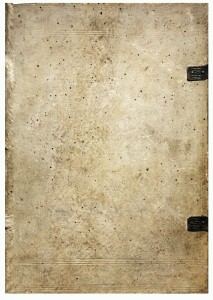

“Rescued” from eBay
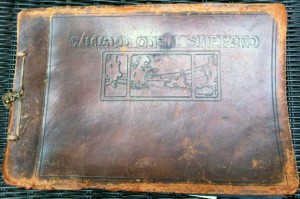 We recently received a gift of a photo album relating to our Odell Shepard collection. It was a Christmas present to Willard Odell Shepard (Odell’s son) from his Aunt Irene Wood in 1914 and has mounted baby pictures and family photos from that year until 1928. There are also a number of loose photos, many taken by Odell, as well as a small, handmade album with additional family photos.
We recently received a gift of a photo album relating to our Odell Shepard collection. It was a Christmas present to Willard Odell Shepard (Odell’s son) from his Aunt Irene Wood in 1914 and has mounted baby pictures and family photos from that year until 1928. There are also a number of loose photos, many taken by Odell, as well as a small, handmade album with additional family photos.
A distant relation to the family “rescued” this from eBay several years ago, and decided to give it to us–an excellent choice, and we will take care of it forever and well!
 “The many kind attentions which I have received from the celebrated author of the Life of Leo the Tenth, joined to the valuable advice with which I have been favoured by that excellent gentleman*[see below], has induced me to honour the little bird before you with his name.
“The many kind attentions which I have received from the celebrated author of the Life of Leo the Tenth, joined to the valuable advice with which I have been favoured by that excellent gentleman*[see below], has induced me to honour the little bird before you with his name.
I shot it in a deep swamp not far from the River Mississippi, in the State bearing the same name, in September 1821. It was flitting among the top branches of a high Cypress, when I first observed it, moving sideways, searching for insects, and occasionally following one on the wing. It uttered a single twit repeated at short intervals. It having unexpectedly flown to a distant tree of the species on a branch of which you now see it, I followed it and shot it. It was the only one of the kind I have ever seen, although I went to the same swamp for several days in succession. It proved a male, and was to all appearance in perfect plumage. The gizzard was nearly filled with very minute red insects, found on Cypress and Pines, the wings of different flies, and the heads of red ants.
In general appearance, this species so much resembles the preceding, that had not its habits differed so greatly from those of the Maryland Yellow-throat, I might have been induced to consider it as merely an accidental variety. On examining it more closely, however, and on comparing it with that bird, I felt, as I now feel, fully confident of its being different.”
–J. J. Audubon, Ornithological Biography, I (1831), 124.
*William Roscoe (1753-1831), historian and patron of arts, was the son of a Liverpool innkeeper who eventually spent two decades in what he described as the laborious and distasteful profession of an attorney. He also enjoyed literary and naturalist pursuits, and was a staunch abolitionist, for which he experienced much pain and suffering in his native city. Roscoe was one of Audubon’s first champions in England, and as the first president of the Liverpool Royal Institution, he provided many valuable contacts to Audubon as the naturalist began to drum up support for his book.
Strike up the band!
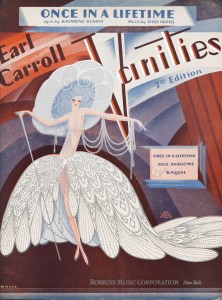 The library has about 25,000 pieces of sheet music in bound volumes or loose in boxes. The latter is divided into two categories, vocal and instrumental, and arranged alphabetically by composer. Most of the sheet music was published in the United States, but there is also a considerable number of English and German publications. The collection encompasses the period from the late 18th century to the 1950’s and covers a wide variety of both classical and popular, sacred and secular music. There are many examples of lithographed covers, popular songs of the late 18th and early 19t centuries, original editions of Stephen Foster, the Christy Minstrel songs, early jazz and blues. For more on our music holdings see our guide to music in the Watkinson.
The library has about 25,000 pieces of sheet music in bound volumes or loose in boxes. The latter is divided into two categories, vocal and instrumental, and arranged alphabetically by composer. Most of the sheet music was published in the United States, but there is also a considerable number of English and German publications. The collection encompasses the period from the late 18th century to the 1950’s and covers a wide variety of both classical and popular, sacred and secular music. There are many examples of lithographed covers, popular songs of the late 18th and early 19t centuries, original editions of Stephen Foster, the Christy Minstrel songs, early jazz and blues. For more on our music holdings see our guide to music in the Watkinson.
The cover shown here is for a song written by Jesse Greer (1896-1970), a pianist and composer who was most active in the late 1920’s through early 1940’s. He often collaborated with lyricist Ray Klages (as here).
Fun Fact: The Greer Music Library at Connecticut College is named in honor of Jesse Greer and his wife, Josephine Lauter Greer.
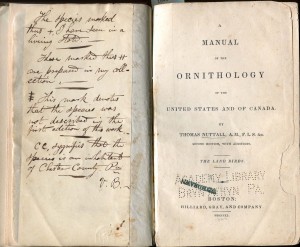 Just acquired, a copy of Nuttall’s Manual of the Ornithology of the United States and Canada (Boston, 1840) which belonged to Vincent Barnard, a 19thC Pennsylvania naturalist.
Just acquired, a copy of Nuttall’s Manual of the Ornithology of the United States and Canada (Boston, 1840) which belonged to Vincent Barnard, a 19thC Pennsylvania naturalist.
The author of the book, Thomas Nuttall (1786-1859), was born in Yorkshire, worked as an apprentice printer in Liverpool, and became so enamored of natural history that he emigrated to Philadelphia in 1808, where he found a mentor and patron in professor Benjamin S. Barton (U Penn). Nuttall then traveled the U.S., from the Great Lakes to New Orleans, and across the southeast. Returning to the Northeast, he lectured at Yale in 1822 (on botany) and was appointed curator of the Botanic Garden at Harvard in 1823, lecturing there until 1834. His study of birds dates from this period, from which the present book was produced.
A former owner of this book was Vincent Barnard (1825-1871), a native of Pennsylvania described as “naturalist, botanist, ornithologist, entomologist, taxidermist, mineralogist, artisan and universal genius.” On one of the blank fly-leaves is written “Vincent Barnard Bought Philada 8th Mo 2nd, 1847,” and a two-page “list of new species described by Audubon discovered since the publication of Nuttall’s manual.” Shown here, opposite the title-page, is an explanation of Barnard’s annotating system:
“The species marked thus + , I have seen in a living state”
“Those marked thus ++ are prepared in my collection.”
“[three vertical plus signs] This mark denotes that the species was not described in the first edition of this work”
“cc signifies that the species is an inhabitant of Chester County, PA.”
 Last night we were happy to host Michelangelo Zaccarello (Università di Verona), a philologist and expert on book history, who held a two-hour “master class” seminar on several early printed books from Italy in the Watkinson’s collection.
Last night we were happy to host Michelangelo Zaccarello (Università di Verona), a philologist and expert on book history, who held a two-hour “master class” seminar on several early printed books from Italy in the Watkinson’s collection.
Professor Dario Del Puppo brought the group together, which included students from both Trinity and UConn. Michelangelo provided a narrative about the history of each book (which included our copy of Galileo’s Diologo (1632), 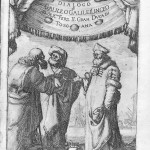 and why he chose these in particular. He also emphasized the book market in Italy in the Renaissance and Early Modern period, and spoke with knowledge about the market conditions for these rarities today.
and why he chose these in particular. He also emphasized the book market in Italy in the Renaissance and Early Modern period, and spoke with knowledge about the market conditions for these rarities today.
CT author on Beards
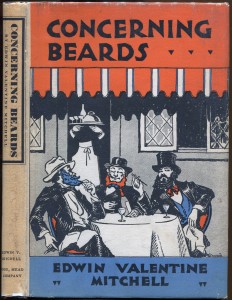 Here is a fun little nugget we just acquired by Connecticut author/bookseller Edwin Valentine Mitchell (1890-1960), published in 1930. “This year,” says the dust-jacket blurb, “may be said to mark the centennial of the beard in the United States. One hundred years ago Joseph Palmer, a friend of Emerson and Bronson Alcott, was flung into jail in Worcester, Massachusetts, as a result of his refusal to shave. To commemorate this event the author has written a history of beards from the earliest times down to the present day, with descriptions of the world’s most famous beards, real, false, and coloured. Many strange and obscure volumes have been delved into for material, and some strange and amusing anecdotes have been retrieved.”
Here is a fun little nugget we just acquired by Connecticut author/bookseller Edwin Valentine Mitchell (1890-1960), published in 1930. “This year,” says the dust-jacket blurb, “may be said to mark the centennial of the beard in the United States. One hundred years ago Joseph Palmer, a friend of Emerson and Bronson Alcott, was flung into jail in Worcester, Massachusetts, as a result of his refusal to shave. To commemorate this event the author has written a history of beards from the earliest times down to the present day, with descriptions of the world’s most famous beards, real, false, and coloured. Many strange and obscure volumes have been delved into for material, and some strange and amusing anecdotes have been retrieved.”
